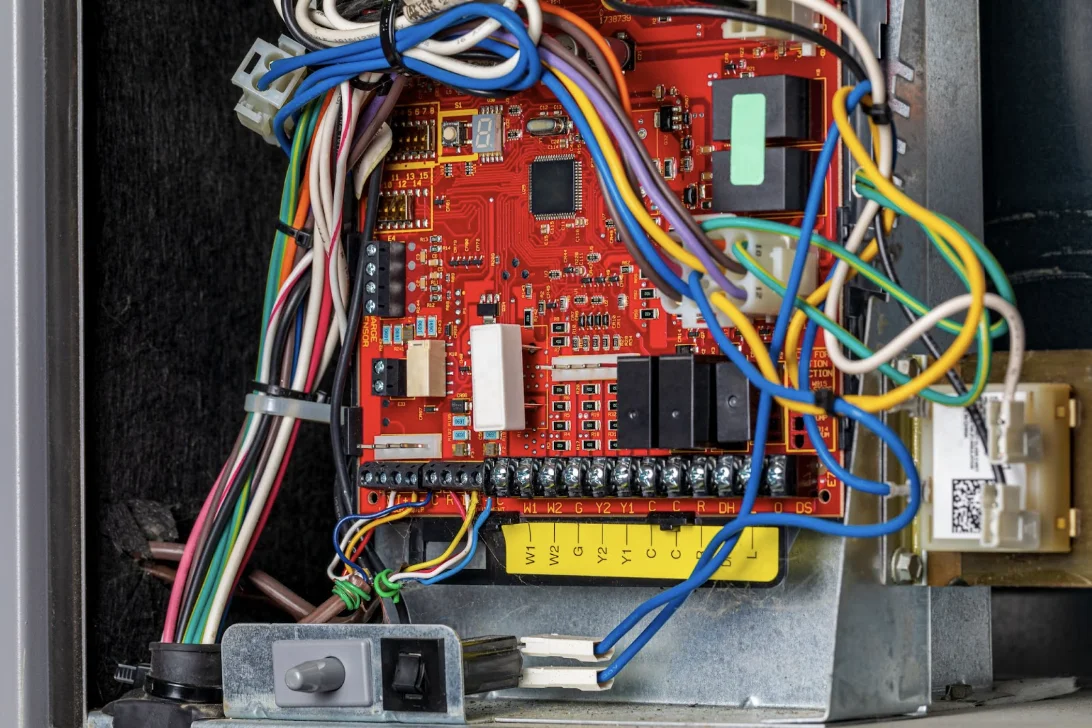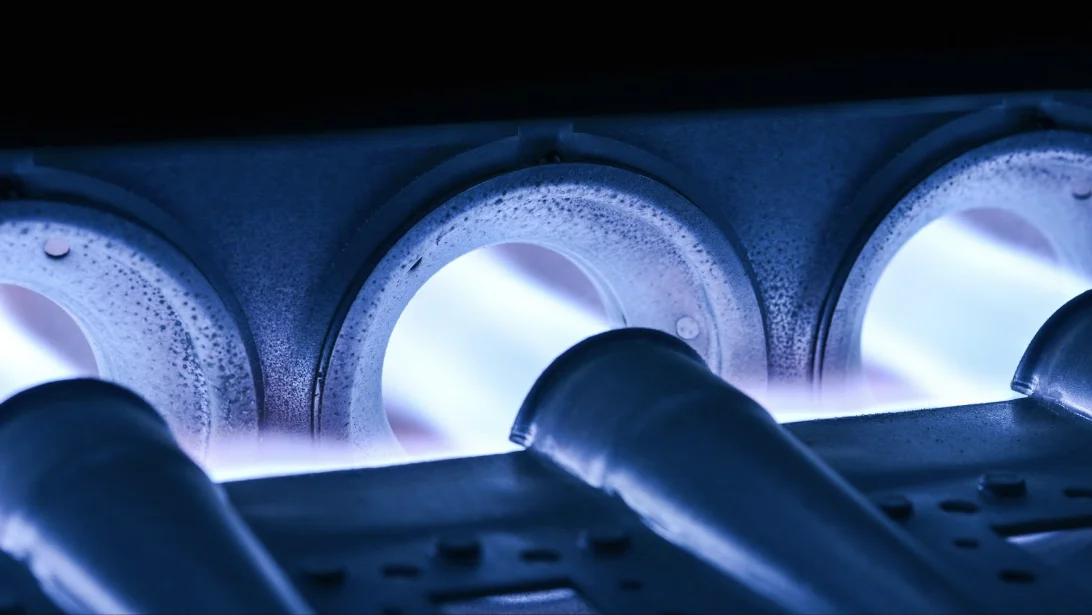Furnace Troubleshooting Guide for Common Furnace Problems
A functional furnace is the key to keeping your home safe and warm. Our HVAC experts have compiled a list of solutions to the most common furnace problems. Follow them and get your malfunctioning furnace back into working order.
- Why Is My Furnace Blowing Cold Air?
- What Should I Do If My Furnace Fan Won't Turn Off?
- What To Do If My Furnace Smells Like Burning?
- How To Fix a Furnace Leaking Water?
- What Should I Do If My Furnace Keeps Turning On and Off?
- Conclusion
Why Is My Furnace Blowing Cold Air?

If your furnace is receiving power but is blowing cold air, several factors could be responsible, including:
Thermostat Issues
Ensure the temperature on the thermostat is set higher than the current room temperature. This should cause the system to turn on and begin heating the home.
If this doesn’t work, replace the thermostat’s batteries and check for any loose or frayed wiring.
While wiring issues will likely require professional repair, at least you will know the root cause of your furnace problems.
Air Filter
A dirty air filter can restrict airflow, causing the furnace to overheat and shut down. Clean the air filter regularly and replace it if necessary. Pay particular attention to the air filter during periods of heavy furnace use.
Pilot Light or Ignition System
If your furnace has a pilot light, confirm the pilot light is lit. If no pilot light is visible, consult your furnace’s manual before attempting to relight it.
If you have a newer furnace with an electric ignition system, you can test it by turning your thermostat up high. The igniter should glow bright, and you should hear the gas control valve click before ignition. If this doesn’t happen, you likely have an issue with your igniter, gas valve, flame sense rod, or control module that will require professional repair.
Don’t hesitate to contact an HVAC professional for assistance if you aren’t comfortable following these steps on your own.
What Should I Do If My Furnace Fan Won't Turn Off?
If your furnace runs continuously and won’t turn off, it can lead to higher energy bills and degrade fan motor components. Here are some steps to diagnose and resolve the issue:
Check the Thermostat Settings
Make sure your thermostat is set to "Auto" and not "On." When set to "Auto," the fan will only run during heating cycles. If it is set to "On," the fan will run continuously, regardless of whether the furnace is producing heat.
Inspect the Fan Limit Switch
The fan limit switch controls the blower's operation. A malfunctioning fan limit switch can cause the fan to run constantly.
Locate the fan limit switch inside the furnace cabinet and check if it's set correctly. It should have an "Auto" and "Manual" setting. Ensure it is set to "Auto." If the switch is damaged or not functioning, it may need to be replaced.
Examine the Control Board

The furnace’s control board manages all its operations. This means a fault in the control board can cause the fan to run non-stop. Inspect the control board for visible damage and burnt components. A malfunctioning control board will need to be replaced by a professional.
What To Do If My Furnace Smells Like Burning?

A burning smell emanating from your furnace is an obvious cause for concern and may be indicative of several issues. Here’s what to do if your furnace smells like burning:
Dust Burning Off
You might notice a burning smell when turning on your furnace for the first time in a while. This is normal. The burning smell occurs when dust that settled on the heat exchanger or other components burns off.
If this is the root cause of the burning smell emanating from your furnace, the smell should dissipate in a few hours. If the smell lasts longer than a few hours, clean your furnace filters and dust off accessible components.
Dirty Air Filter
A dirty air filter can cause the furnace to overheat, producing a burning smell. Inspect the air filter for dust and debris and clear any present. Regularly cleaning the air filter will prevent future burning smells and make your system more efficient.
Electrical Issues
A burning smell might indicate overheating wiring or components. Turn off your furnace immediately and inspect the wiring and connections. Look for any signs of melting or burning. This type of issue requires the attention of a professional HVAC technician.
Plastic or Debris Over Vents
Vents can get quite hot, and if there is anything touching them when they reach these high temperatures, it can produce a burning smell. Check around your living space for objects or debris blocking vents and remove them.
Mechanical Issues Inside the Furnace
A persistent burning smell might indicate a mechanical issue within the furnace, like a failing heat exchanger or burner. If you suspect this is the case, turn off the furnace and contact a professional HVAC technician for inspection and repairs.
How To Fix a Furnace Leaking Water?

There are several reasons why your furnace might be leaking water. Here's how to address them:
Condensate Line Issues
Check if the condensate drain line is clogged with debris or algae. If it is, you can clean the line with a mixture of water and vinegar. Allow the solution to sit for at least 30 minutes before flushing it out.
Humidifier Leak
If your furnace has an integrated humidifier, inspect it for leaks. Ensure the humidifier is properly connected and the water panel is not clogged or damaged.
What Should I Do If My Furnace Keeps Turning On and Off?

If your furnace frequently cycles on and off, it can indicate a serious underlying issue. This problem, known as short cycling, can cause your energy bills to rise and can lead to permanent damage to your furnace. Here’s how to identify and fix the issue:
Check the Flame Sensor
The flame sensor ensures the furnace’s burners are operating correctly. If the sensor is dirty or broken, it can cause the furnace to shut off.
Clean the dirty flame sensor with a gentle abrasive pad or replace it if necessary. If you’re not comfortable doing it yourself, reach out for professional assistance.
Inspect the Blower Motor
A malfunctioning blower motor can cause the furnace to overheat and shut down. Ensure the blower motor is clean and lubricated. If the motor is damaged, contact a professional HVAC technician for repair or replacement.
Ensure Proper Ventilation
Blocked or obstructed vents can cause pressure issues within the furnace, leading to short cycling. Ensure all supply and return vents are open and unobstructed. Additionally, inspect the flue and exhaust vents for blockages and clear them.
Wrong Furnace Size
If your furnace is too large for your home, it can heat the space too quickly and shut off prematurely. Consult with an HVAC professional to determine if your furnace is appropriately sized for your home. If it’s too large, you may need to replace your furnace with a correctly sized unit.
Conclusion
Regular maintenance and timely troubleshooting can prevent many common furnace issues, ensuring your heating system operates efficiently and reliably. By following these guidelines and addressing problems promptly, you can enjoy warm air on demand.
For professional assistance and comprehensive furnace maintenance, contact Wolfgangs Cooling, Heating & Plumbing at (928) 767-8905. Our HVAC experts are ready to help you with all your furnace needs.








